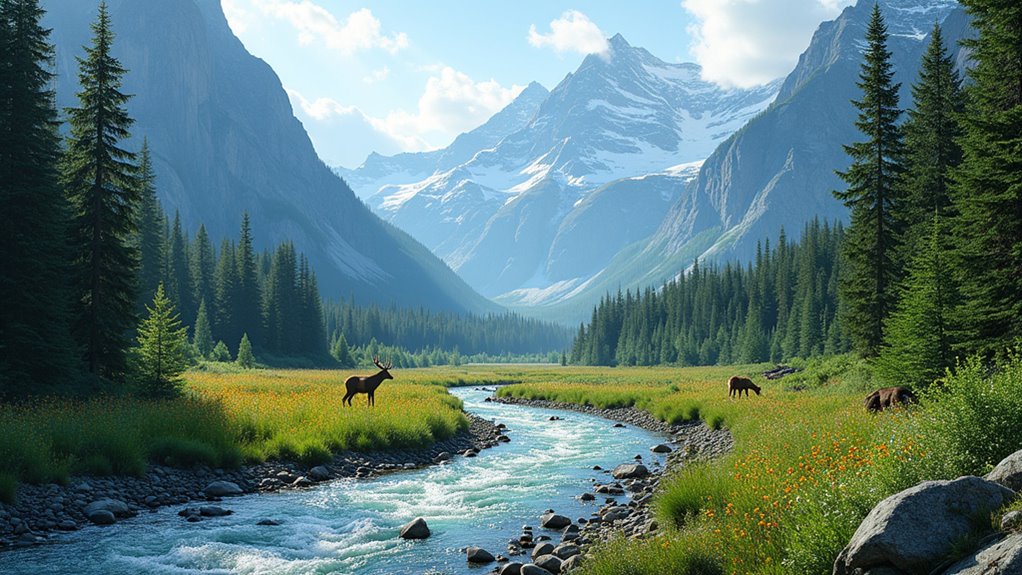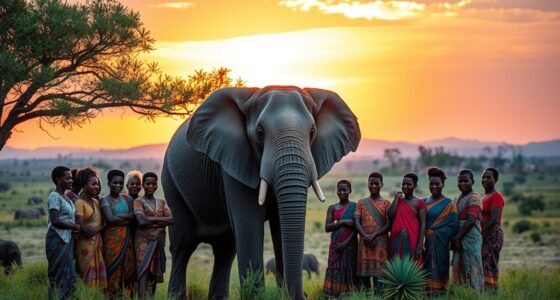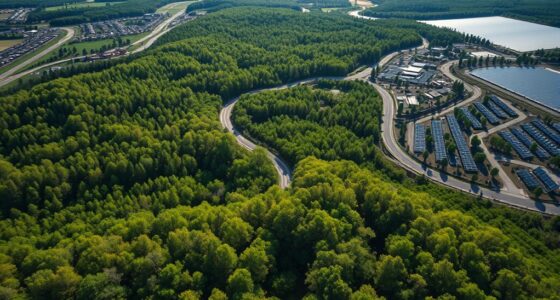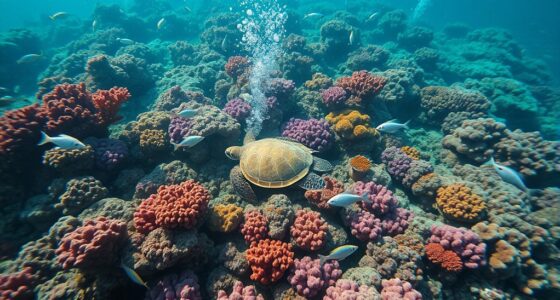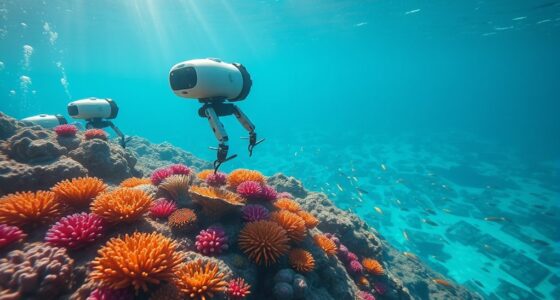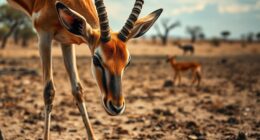National parks are essential for wildlife conservation because they provide safe habitats where animals can live, breed, and thrive without threats from deforestation and urbanization. They help protect biodiversity, maintain ecosystems, and support natural processes like food chains and climate regulation. These protected areas also serve as centers for education and awareness, inspiring action to sustain our natural heritage. If you want to understand how these parks make a difference, keep exploring their indispensable role in preserving our planet’s wildlife.
Key Takeaways
- They serve as protected habitats, safeguarding endangered species from threats like deforestation and urbanization.
- National parks preserve entire ecosystems, maintaining ecological balance and supporting biodiversity.
- They act as genetic reservoirs, ensuring species’ adaptability and resilience to environmental changes.
- Parks facilitate ecological processes such as breeding, migration, and natural behaviors of wildlife.
- They promote environmental awareness and support conservation efforts through education and connectivity.

Have you ever wondered why protecting national parks and wildlife matters? It’s because these natural areas serve as essential refuges for indigenous species that would otherwise face threats from deforestation, urbanization, and climate change. When you visit a national park, you’re witnessing a carefully maintained environment that supports a wide array of wildlife, many of which are found nowhere else on Earth. These parks aren’t just beautiful landscapes—they’re necessary for habitat preservation, ensuring that animals and plants have a safe space to live, breed, and thrive. Without them, many species would struggle to survive in fragmented or degraded environments, risking extinction.
National parks act as living laboratories for biodiversity. They protect entire ecosystems, allowing indigenous species to continue their natural behaviors without disruptive human interference. When habitat preservation is prioritized, it helps maintain the delicate balance of food chains and ecological processes. For example, large predators, herbivores, and pollinators all depend on intact habitats to fulfill their roles. Preserving these habitats also safeguards genetic diversity, which is vital for species’ ability to adapt to environmental changes. Protecting these spaces also means safeguarding the genetic diversity necessary for species to adapt to changing conditions. When habitats are preserved, you support the resilience of wildlife populations, enabling them to withstand threats like disease outbreaks or climate shifts. Additionally, maintaining healthy ecosystems helps buffer against the impacts of extreme weather events, further emphasizing their importance.
National parks preserve ecosystems, supporting species’ natural behaviors and ecological balance for a resilient, thriving wildlife community.
By conserving national parks, you’re also helping to sustain the natural services that ecosystems provide. These include clean air and water, fertile soil, and climate regulation. Indigenous species, which have evolved over thousands of years within specific habitats, are particularly vulnerable to disturbances. When their habitats are preserved, you ensure they continue to perform their ecological functions, which in turn benefits human communities. For instance, many parks help prevent soil erosion and filter pollutants, serving as natural buffers against environmental hazards. Protecting these habitats also supports ecosystem resilience, which is vital for adapting to environmental changes. Additionally, preserved habitats serve as genetic reservoirs, helping to conserve the biodiversity essential for ecological stability. These natural buffers are especially critical as climate change accelerates, making the protection of habitats more urgent than ever.
Furthermore, national parks foster environmental awareness and education. They give you the chance to observe indigenous species in their natural habitats, fostering appreciation and understanding. This connection often motivates people to support conservation efforts beyond park boundaries. When habitat preservation is emphasized, it’s easier to restore degraded ecosystems and expand protected areas, creating larger, interconnected landscapes that benefit wildlife. Such interconnectedness enhances habitat connectivity, allowing species to migrate and adapt more effectively to environmental pressures.
In essence, national parks aren’t just about recreation—they’re about safeguarding the natural world. They serve as critical sanctuaries for indigenous species, ensuring habitat preservation for generations to come. By doing so, you help maintain ecological integrity, protect biodiversity, and promote a healthier planet. When you support and visit national parks, you’re actively participating in the vital effort of conservation, ensuring that these wild places and their inhabitants continue to enrich our planet’s natural heritage.
Frequently Asked Questions
How Do National Parks Impact Local Communities Economically?
National parks boost local economies through eco tourism benefits, attracting visitors who spend on lodging, food, and activities. This influx creates jobs and supports small businesses. Your community can also engage residents in park initiatives, fostering pride and stewardship. By promoting eco tourism and active community engagement, national parks help sustain local economies while preserving natural and cultural heritage, ensuring long-term benefits for everyone involved.
What Measures Are Taken to Prevent Illegal Poaching Inside Parks?
Imagine a fortress protecting precious treasures—that’s what parks do against illegal poaching. You can see that anti poaching tactics, like patrols and community engagement, work alongside advanced surveillance technologies to catch poachers. Park authorities also use cameras, drones, and tracking devices to monitor wildlife and prevent illegal activities. These combined efforts create a strong shield, ensuring that wildlife remains safe and protected from threats.
How Do Parks Adapt to Climate Change Affecting Wildlife?
You see parks adapt to climate change by boosting climate resilience and improving habitat management. They monitor environmental shifts and adjust conservation strategies to protect vulnerable species. Parks might restore habitats, create wildlife corridors, or implement water conservation efforts. These actions help wildlife cope with changing conditions, ensuring ecosystems stay balanced. Your support for these measures helps parks continue safeguarding wildlife and maintaining healthy, resilient habitats amidst climate challenges.
Are There Specific Species That Benefit Most From Protected Areas?
Imagine standing in a lush, untouched forest where endangered species find refuge. You see rare birds soar and elusive mammals hide in dense foliage—these protected areas preserve crucial habitats. You realize that species most benefiting from these sanctuaries are often endangered, relying on habitat preservation to survive. By safeguarding these areas, you help guarantee the survival of wildlife teetering on the brink, giving them a fighting chance to thrive again.
How Can Visitors Contribute to Wildlife Conservation Efforts?
You can actively contribute to wildlife conservation by participating in volunteer programs offered at national parks. These programs allow you to help with habitat restoration, wildlife monitoring, and educational outreach. Practice responsible tourism by following park rules, avoiding littering, and respecting wildlife. Your efforts support conservation goals, protect ecosystems, and guarantee future generations can enjoy these natural wonders. Every small action counts in preserving wildlife and their habitats.
Conclusion
By protecting national parks, you play a pivotal part in preserving precious populations and promoting peaceful coexistence. Your support sustains species, secures ecosystems, and safeguards skies, soils, and souls. When you cherish these cherished corners of nature, you champion change and champion conservation. So, step up, stay steadfast, and stand for the sanctuaries that serve as safe havens for wildlife. Together, your commitment can create a lasting legacy of lush landscapes and lively creatures.
